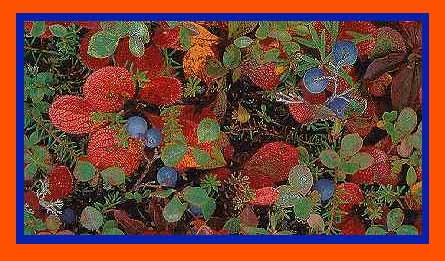
aka wild blueberries, bot whortleberry, Arctic or Alpine blueberry

The Heath family is also well-represented among the fruits of the Arctic and subarctic. Again, many berries beloved down south find a hearty echo in the wild berries up north. According to Karen Johnson, author of Wildflowers of Churchill and the Hudson Bay Region, "Arctic Bilberry," Vaccinium uligonosum var alpinum, produces a fine fruit indeed. "...this common small shrub produces delicious sweet and juicy berries. They make excellent jam and pies and also dry well, having been used as dried berries in many ways by native peoples. Northern residents complain about our higher southern berry bushes saying that they prefer to be able to lie down and pick their berries--which they can do for all the northern species. ... but keep your eyes open for polar bears while you pick!"
The Arctic Bilberry, also known as "Bog Whortleberry," "Blueberry" or "Arctic Blueberry" is a low-growing much branched shrub. The thick dull-green oval leaves, pale and finely veined beneath are deciduous. The tiny bell-shaped pink or white flowers bloom in late June to the end of July.
According to M. Walker, Harvesting the Northern Wild, the low or upright shrub colonizes a variety of habitats, including thickets, woods and alongside streams. Others of this species grow in muskegs and peaty or turf areas. The flavor of Arctic Bilberry fruit is said to be far superior to cultivated blueberries. Unfortunately for me, I arrived and departed too early to experience these. Next year, I want to go up in late August or early September, after the first frost has killed off the bugs, when berries have ripened and the tundra is said to be as brightly colored as any New England autumn.
Walker gives an interesting method for cleaning wild blueberries: drop them a handful at a time onto a tightly stretched wool blanket laid in place over a wide basin at its lower edge. Ripe berries will roll into the basin, leaving leaves and debris behind. Unripe berries tend to bounce. She gives directions for using the leaves as a traditional cure for diarrhea: "Mix part strawberry and blueberry leaves and thyme for tea."
The Dene of Great Bear Lake made dye from this fruit to be used for coloring
skins and porcupine quills. A scholar named Osgood, writing back in 1930,
related how the Kutchin people would fill a wooden dish and mash these berries
with a spoon. They would then take the processed fruit and put it in a birch
bark basket. A cover would be sewn on and the whole mess buried in the ground
until winter. The Kutchins then used this product as trade to whites. According
to Mason, writing in 1946, Dene women boiled the fruit with grease to preserve
it.
Sources:
"Wildflowers of Churchill and the Hudson Bay Region," Karen
L. Johnson. (published by Manitoba Museum of Man and Nature, in 1987)
Harvesting the Northern Wild, Marilyn Walker, The Northern Publishers,
Box 1350 Yellowknife, NWT X1A 2N9, 1984;
TheAmerican Indian Ethnobotany
Database
The Flora of Churchill, Manitoba 7th edition, 1991 by Peter A. Scott, Dept. Zoology, U Toronto 25 harbord Street, Toronto, Ontario CA M5S 1A1
Go On to Cloudberries
Return toAutumn Fruit
Return toFall Colors and fruit
Return toFlowers and Fruitindex page. Created 12/20/96